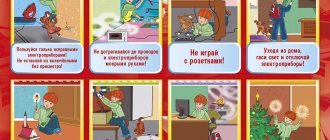n. Rights of the child
Do you consider yourself to be a child? At what age can a teenager be considered an adult? Whatever each of us thinks about this, if a person has not yet turned eighteen, then
legally he is considered a child
. The law makes some exceptions to this rule. A minor can be recognized as fully capable if he undergoes the emancipation procedure or gets married. But we will talk about these exceptions separately.
The idea that children's rights should be protected in some special way has penetrated into public consciousness relatively recently. Moreover, for a long time children were basically denied the opportunity to have any rights
.
If you are interested, then you can easily find materials about the indifferent and extremely cruel attitude towards children in ancient times, in the Middle Ages and even in modern times in different regions of the world. Let's see how this problem was solved in Russia.
Describe the situation of children in families of Ancient Russia
in one word – powerless. The father's power was limitless. Parents could send their children into slavery. In the family they stood on the same level as the servants. This category of persons was designated by the term “child”. This is where the completely neutral and even tender word “child” comes from now.
Before the adoption of Christianity, society was quite tolerant of infanticide. No, this was not a common rule, but in difficult times, when there was not enough food for everyone, reducing hungry mouths by physically eliminating them was not particularly frowned upon.
The Church took the lives of children under protection, but, of course, it could not “cancel” the difficult times. When they came, the number of children sold to strangers or even given to them as a gift increased. A new tradition has also emerged - throwing an “extra” child on the porch, at the church doors.
In the 16th century, two very important documents were adopted, which contained norms of family law, including those defining the status of children. This is Domostroy
and "Stoglav". They consolidated the child's powerless position. Parents could and even had to keep their children “in a black body.” “Domostroy” directly called on the father to punish them physically: “by beating him [the child] on the body, you will deliver his soul from death.”
Children were charged with the duty to be obedient to their parents and take care of them: “and you will honor their old age, and you will bear all infirmities and sorrows with all your soul on your neck, and it will be good for you...”
Domostroy actually explicitly forbade playing and laughing with children. But at the same time, he demanded that parents not neglect their upbringing and maintenance. And then: laws are laws, written rules are rules, and there have always been loving, caring and gentle parents.
The first secular legal document that regulated family relations was the Council Code of 1649. Its rules prohibited children from complaining about their parents. Infanticide was not a serious crime. The punishment for it did not exceed one year in prison. While the murder of parents entailed the death penalty.
By the way, the Council Code still respected the right of children to life. If for some reason a pregnant woman was sentenced to death, execution was postponed until the birth of the child. Interesting fact. The murder of an illegitimate child by a mother was considered a much more dangerous crime than that of a legitimate child. It was punishable by death. What was this connected with? Try to find the answer to this question yourself.
The attitude towards children depended on their gender. They were more interested in raising the boy. He was seen as "hope and support" for the future. Girls were often considered a burden, especially in poor families.
After all, when they get married, they will need to be given a dowry, weakening the family’s material base.
During the reign of Peter the Great
The first attempts were made to create a legal framework to support children. A number of decrees of the emperor imposed on the state the obligation to take care of orphans and children who found themselves in difficult financial situations. The status of illegitimate children has become somewhat stronger. Their biological fathers had to either marry the woman with whom they had an affair or pay a fine to support the mother and baby.
The minimum age for marriage was raised to 17 for women and 20 for men. Before this, the age of marriage was 12 and 15 years, respectively. Although Peter did not succeed in banning the sale of serfs without land, at least there was a rule according to which families should not be divided.
These and other decrees of Peter were implemented with great difficulties. Society was not ready to accept the idea of children having personal rights and their protection by the state. But certain shifts in public consciousness still occurred. The peasant family remained patriarchal at the beginning of the twentieth century.
But in the families of nobles and urban intelligentsia, views on family structure changed. Relations between spouses, parents and children have gradually democratized. Respect for the individual and her interests, regardless of gender and age, became increasingly evident.
Similar changes, some faster, some slower, occurred in other regions of the world. Eglantine Jebb, founder of Save the Children International, drafted the Declaration of the Rights of the Child
.
In 1924, the Assembly of the League of Nations adopted it. The Declaration contained five basic principles that were to guide members of the League of Nations.
· Providing each child with the means necessary for his development, physical and spiritual.
· Fighting hunger among children, providing medical care to every sick child, fighting homelessness.
· Priority provision of assistance in difficult situations (wars, natural disasters, etc.) to children.
· Protecting children from all forms of exploitation.
· Raising in children the best moral qualities, an understanding that their actions should be aimed at benefiting people.
In 1959, the UN General Assembly adopted a new Declaration of the Rights of the Child
.
It states that the child should have all the rights proclaimed by the Universal Declaration of 1948. But children, due to their physical and mental immaturity, need special protection and care. And without the assistance of the state, it will be very difficult to ensure a happy childhood for all of them. Therefore, the UN called on its members to follow the ten fundamental principles
.
· Do not discriminate against children on any basis, including whether they were born within or out of wedlock.
· Create favorable conditions for their physical, mental and moral development.
· Recognize the child’s right to a name and citizenship from the moment of his birth.
· Provide social support for motherhood and childhood.
· Create special conditions for children born with special needs in physical or mental development.
· Recognize the child’s right to be in the family, except in special circumstances. And create a state system of assistance to orphans and children in difficult situations.
· Provide access to education. At the very least, primary school should be compulsory for everyone, with free education.
· Include children in the group of people who, in any circumstances, are the first to receive the necessary help.
· Protect children from neglect and all forms of exploitation. Do not allow them to be hired until they reach the age minimum established by national legislation.
· Protect children from those conditions of upbringing that encourage discrimination against a person on racial, religious or other grounds.
We have already talked about the fact that declarations are not binding for those who sign them. In the International Year of the Child (1979 was declared), the Polish delegation to the UN proposed the adoption of a Convention on the Rights of the Child
. Work on her project lasted 10 years, and in 1989 the General Assembly of the United Nations adopted it. The day this happened, November 20, began to be celebrated as World Children's Rights Day in 1996. The Convention was supplemented by three optional protocols.
Its content is much more extensive compared to the 1959 Declaration. But the basic principles that we just named remain unchanged. What's new in it?
· Recognition of the right of children to freely express their views, freedom of conscience, and the creation of public associations.
· Introducing state responsibility in protecting children from illegal drug use, seduction and abduction.
· Prohibition of the death penalty or life imprisonment for criminal offenses against minors.
· The duty of the state to inform the population (both adults and children) about the standards included in the Convention.
· Recognition of the possibility of adopting orphans to another country only if it is not possible in their home country.
Optional Protocols
are devoted to the prohibition of the use of children in armed conflicts, the fight against the sale of children, child prostitution and pornography, as well as providing a child with the right to complain to the UN Human Rights Committee about state actions that violate the Convention.
As of mid-2022, only the last, Third Optional Treaty has not been ratified by Russia.
The norms of the Convention on the Rights of the Child and its two Optional Protocols are included in Russian legislation
. When studying this issue in detail, first of all you should get acquainted with the Federal Laws “On Basic Guarantees of the Rights of the Child” and “On Education in the Russian Federation”. Norms protecting the rights of children are included in the Family, Labor, and Criminal Codes of Russia. Regulatory acts on this issue are adopted by the subjects of the federation and local governments. After all, the charters of educational institutions also contain sections on the rights and responsibilities of students. And they should in no way contradict what all the documents listed above establish.
of Commissioner for Children's Rights was introduced on September 1, 2009.
. He is appointed by the President of Russia. Such positions were also introduced in the constituent entities of the federation.
Children have the opportunity to exercise some of their rights upon reaching a certain age. Can you immediately fill out the table “The rights of a child depending on his age”? Or do you need to work more closely with the sources?




